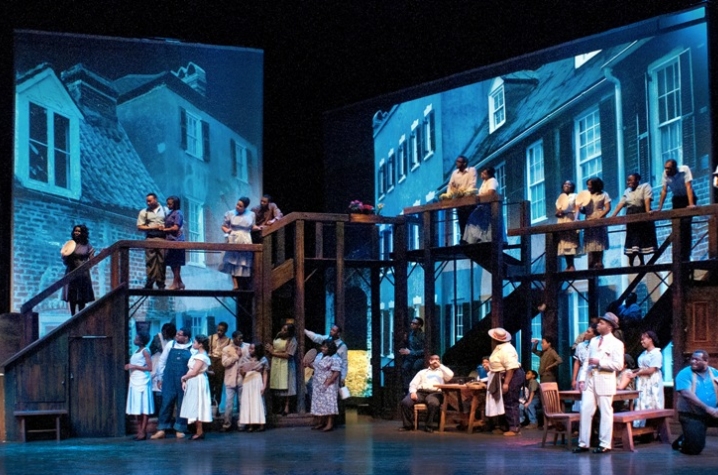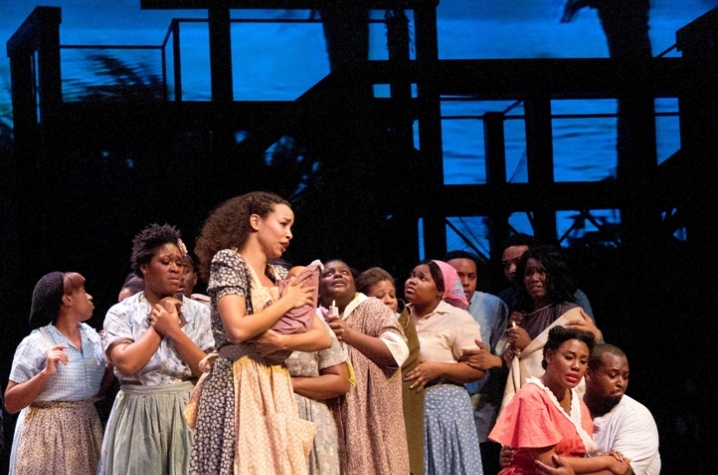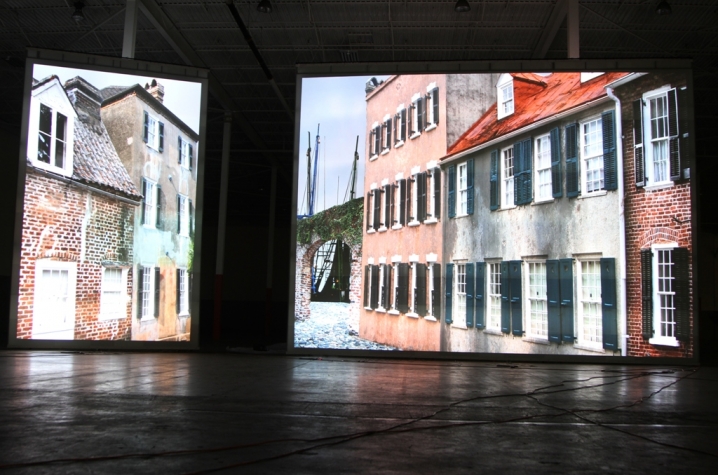Projection Technology Debuts with 'Porgy and Bess'
LEXINGTON, Ky. (Jan. 24, 2011) − As the curtain rises on University of Kentucky Opera Theatre's production of the American classic, "Porgy and Bess," new scenic projection technology developed by the UK Center for Visualization and Virtual Environments will also be in the spotlight as it makes its debut in a theatrical setting. Don't miss this opportunity to see what is considered America's first great opera updated with innovative video scenery as its backdrop to be presented 7:30 p.m. Jan. 28-29 and Feb. 3-5, and 2 p.m. Feb. 6, at the Singletary Center for the Arts Concert Hall.
"The technology used in our production of 'Porgy and Bess' will revolutionize the theatre and answer a major question in theatre: How to produce Grand Opera in theatres not equipped with a fly system or off-stage wing space," says Director of UK Opera Theatre Everett McCorvey.
The acclaimed American folk opera "Porgy and Bess" was first performed in 1935 with music by George Gershwin, libretto by Dubose Heyward, and lyrics by Ira Gershwin and DuBose Heyward. Set in fictitious Catfish Row in Charleston, S.C., in the early 1920s, the opera follows Porgy, a disabled black beggar living in the slums, in his attempts to rescue Bess from Crown, a violent and possessive lover, and Sportin' Life, a local drug dealer. Audiences will recognize several popular songs from this opera, including "Summertime," "It Ain't Necessarily So" and "I Loves You Porgy."
Joining UK Opera Theatre vocalists for this production are members of the Kentucky State University Choir and the celebrated American Spiritual Ensemble under the direction of Lemuel Wade. UK Symphony Orchestra will perform under the direction of John Nardolillo.
The Vis Center's new innovative high-definition projection technology, originally developed for non-theatrical use, will be used for the first time in a theatrical setting for the UK production, and then will travel to The Atlanta Opera for performances of the opera Feb. 26-March 6. This will be the first professional opera company to use this technology.
"This is ground-breaking scenic technology for the theatre" says McCorvey. "The possibilities for scenic elements using the technology are limitless. Using scenic content like this is just the first of many ways that scenic technology may be used in opera, theatre and many other parts of the performing arts industry."
The technology, coined by the Vis Center as SCRIBE (self-contained rapidly integratable background environment) utilizes a software system that blends the projections into one image, which will include still images and video related to the various scenes in the production. The technology was originally developed at the Vis Center through a partnership with Fort Knox. Its initial application was for the military with the goal of building rapidly deployable, high resolution screens to be used in training or battle. Other potential uses include any environment that needs the mobility and convenience of a display from schools to museums and medical applications.
While front and rear projected backdrops are nothing new to theatre, they can cause problems for the set design and for the performers. Normal front projectors can cast shadows and images onto the performers, and normal rear projectors must be placed very far distances behind the screens to create a large enough image of scenery, which can limit the stage space. With the Vis Center's new rear projection system, only four and a half feet separate the 54 projector units from their attached moveable fabric screen units, which are an impressive 24x30' and 24x15'.
This project grew out of the synergy that is possible through multi-disciplinary research collaboration. The director of the Vis Center, Brent Seales, came into contact with McCorvey through a chance meeting when they were both speaking at a luncheon hosted by UK First Lady Patsy Todd. Both quickly grasped the possibilities of collaboration and over the next year, the idea of using this technology as part of the opera production emerged.
Seales states that this type of multi-disciplinary research is the goal of the Vis Center.
"We plan to see more of these type of real applications of our technology continue to take place as we work with other researchers across the university in the future," said Seales. "The possibilities are amazing if you consider what research can do when people step outside of their regular environments to interact with those with a distinctly different background."
Bill Gregory, lead engineer for the Vis Center, reflected on the value of applying his technical ability to the theatre production.
"It’s been fascinating to work with the theatre crew," said Gregory. "Being an engineer, I am focused on the practical results and never look at the artistic aspect, while the people in UK Opera didn’t realize the technology that could be used to achieve their artistic ends. We didn’t know what problems existed for them and they didn’t know what to ask for until we collaborated."
The images will depict real locations in Charleston, S.C., and the islands off the coast of North Carolina that were taken and edited by the Vis Center team, led by set designer Richard Kagey. Actual hurricane footage from The Weather Channel will be used as well. Combining these projected images with a minimal amount of three-dimensional pieces of scenery will create a vibrant and exciting production.
The use of this projection system continues to draw interest from other opera and theatre companies from around the country.
"We have already had many opera companies from around the country fly to Lexington to see the new technology," said McCorvey. "After the Atlanta production is complete, UK Opera and the Vis Center plan to license the technology to a company that will be formed to allow opera companies around the world to use the technology."
Ticket prices for "Porgy and Bess" range from are $45 for general admission; $40 for UK faculty/staff and senior citizens; $15 for students; and $10 for children under 12. Tickets can be purchased from the Singletary Center Ticket Office in person, by phone at (859) 257-4929, or online at www.singletarytickets.com. A handling fee will be added upon transaction.
To view a transcript of the video, click the attachment below the photo viewer.











